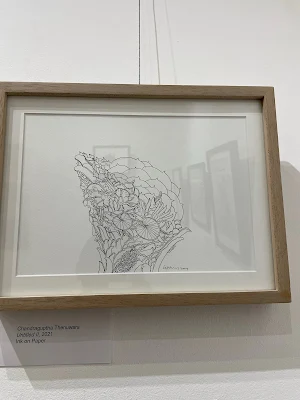Aragala Exhibition - Harrow Art Centre
~~~~~~~~~~~~~~~~~~~~~~~~~~~~~
There was an exhibition at Harrow Arts Center organized by the University of Essex, the University of Newcastle Fund, and some local organizations, including "Agora." The exhibition aimed to showcase paintings created during the "Aragalaya" or "Uprising" that occurred in Sri Lanka in July 2022.
The exhibition served as a commemoration of the event and also provided a platform for discussing what truly transpired during those times. There were allegations of mishandling funds and receiving kickbacks from Western countries, but one thing everyone agrees on is that it occurred out of dire necessity. People have been struggling due to the impact of COVID-19, and the ill-advised decisions made by the Rajapaksa government pushed the Sri Lankan economy to the brink of collapse. While the situation was temporarily averted, the danger still looms due to ongoing wars and other uncertainties on the global stage.
However, the exhibition serves as a reference point and a testament to the freedom of expression earned through the courageous acts of the masses during those tumultuous 'aragalaya' days, depicted through various art forms. It serves as a powerful reminder to the establishment that the true power lies in the hands of the people. No matter how hard they try, the ruling class cannot take that power away from them. In any country, there will always be a time and a space for an anarchic situation like that if the ruling class continues to ignore the issues faced by the masses. They do so at their own peril. This message is conveyed loud and clear.
Here are some of the pieces on display.
6. "The Tragedy of the Terrorist Mentality" by Sujith Rathnayake sheds light on the lasting impact of the Prevention of Terrorism Act enacted in 1979. Despite the passage of many decades, the act still remains in effect. This legislation has opened the door to arbitrary detention and state-sanctioned torture inflicted upon civilians. The artwork serves as a stark reminder of the tragic consequences resulting from the mindset associated with terrorism, including the erosion of civil liberties and the violation of human rights by the state.
8. "Oppression in Isolation" by Sujith Rathnayake presents a unique concept of art within art, or paintings within a painting, illustrating the inner and outer turmoil experienced by the masses. The artwork depicts individuals who are barricaded within the confines of oppressive laws, symbolizing their isolation and the restrictions placed upon them. Simultaneously, the painting also portrays those outside the barricades, who are in a state of even greater turmoil. This juxtaposition emphasizes the pervasive nature of oppression and its impact on both the individuals directly affected and the broader society. The artwork prompts contemplation about the interconnectedness of oppression and its far-reaching consequences.
DELUSION
Chandraguptha Thenuwara’s memorial exhibition in July, will take place at three locations, marking 40 years since the events of 1983 anti-Tamil pogrom.
Delusion which will open at Saskia Fernando Gallery will present Thenuwara’s annual exhibition of new works in response to the sociopolitical climate in Sri Lanka. The exhibition will continue his inquiry into issues of militarism, religious extremism, conspiracy theories, Sinhala chauvinism, narrow-minded nationalism, anti-western agitation, socialism etc.
As an extension of this exhibition, the complete sculptural installation Covert will be presented to the public, a part of which was exhibited at the 2022 Venice Biennale, at the Lionel Wendt Art Gallery. Through an infinite vortex of interlocking motifs - lotuses, soldiers, stupas and barrels - constructed out of wire which link and fuse, layer upon layer, like the meanings of the motifs themselves - the artist invites the viewer to reflect on the social and political history of the island.










No comments:
Post a Comment